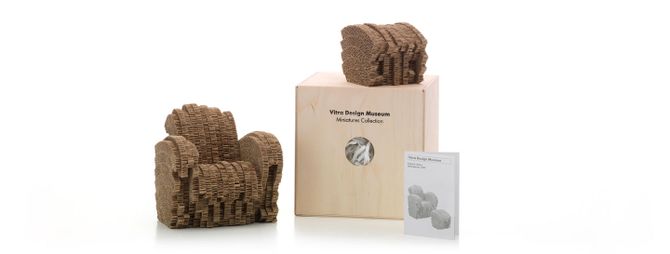
Miniatures Collection - Little Beaver
Frank Gehry, 1986
Gehry chose a different method, which gave birth to sturdy cardboard furniture like carboard sculptures: »One day I look in my office at a pile of corrugated cardboard, the material I normally used to make architecture models, and I began to experiment with it, to stick it together and to cut it into shape with a hand saw and a penknife«. Following his »Easy Edges« from 1972, a series of extraordinarily sturdy cardboard furniture with a smooth surface, from the end of the 1970s onwards Gehry once again devoted his attention to the use of corrugated cardboard as a material for making furniture.
»Experimental Edges« was the name given to unusually expansive armchairs and easy chairs with a rough, ragged- looking surface. Strips of thick cardboard usually used as the filling for door leafs were sawn or cut vertically to the corrugation lines and fashioned into solid volumes of varying shapes. Using this method, single items or small series of furniture were created, which were both furniture sculptures and surprisingly comfortable chairs and sofas.
Miniatures Collection
Al meer dan twee decennia lang maakt het Vitra Design Museum miniatuurreplica’s van de mijlpalen in meubeldesign uit zijn collectie. De Miniatures Collection belichaamt de volledige geschiedenis van industrieel meubeldesign: van historicisme en art nouveau tot Bauhaus en nieuwe zakelijkheid, van Radical Design en postmodernisme helemaal tot aan de huidige periode. De stoelen, die precies een zesde van de grootte van de historische originelen zijn, zijn volledig op schaal en geven zelfs de kleinste constructie-, materiaal-, en kleurdetails nauwkeurig weer. De authenticiteit van de meubels gaat zo ver als de natuurlijke nerf van het hout, de reproductie van schroeven en de minutieuze handwerktechnieken. Dit maakt van de miniaturen geliefde verzamelobjecten maar ze zijn ook bij uitstek geschikt als didactisch materiaal voor universiteiten, designacademies en architecten.